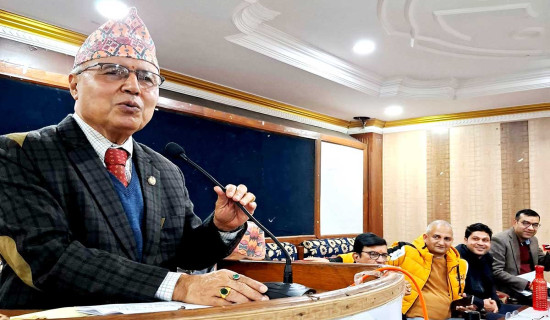- Monday, 8 December 2025
Pay Heed To Nature's Rhythm
A series of recent natural disasters shows that the weak and poor mountainous nations are highly vulnerable to such disasters. A earthquake of 6.1 magnitude struck the province of Paktika in Afghanistan last June, killing at least 1,000 people and leaving around 1, 500 injured. The deadliest quake to hit the war-torn country in two decades also rattled parts of Pakistan and India.
While in the early hours of Saturday (July 2), three quakes of magnitude 6.1 to 6.3 hit the province of Hormozgan in southern Iran at a depth of 10 km, killing five people and flattening homes. This is one of a series of powerful quakes to hit southern Iran in recent months. International news agencies, quoting the state TV, said 150 quakes and tremors have hit western Hormozgan over the past month.
Landslide
In the Andean nation of Peru, a massive landslide occurred on Thursday afternoon (July 1) in Chavi de Huantar, damaging 150 homes. Closer home, more than 40 people have died and several others have gone missing in a landslide that occurred at the Tupul yard railway construction site in Noney in the mountainous state of Manipur, India, on June 29. Incessant rains and fresh landslides have hampered rescue efforts.
As per media reports, the victims include migrant workers and a volunteer force of the Indian Army. Furthermore, the debris from the landslide has dammed the Ijei River, posing a threat to the downstream. After the landslide event, there have been calls to review the railway project, given the fragility of the mountains, even as officials continue to blame incessant rains for the disaster. Other north-eastern states like Assam, Meghalaya and Tripura have been grappling with monsoon-induced flooding and inundation even as monsoon havoc continues in other parts of India like Uttar Pradesh and Bihar.
As for Nepal, several events of natural disasters like earthquakes have shown how vulnerable the country is. The government seems well aware of disaster risks facing the country. The Disaster Risk Reduction portal of the government http://drrportal.gov.np/) states, “Located in the central of the Himalaya range (sic), Nepal is one of the most disaster prone countries in the world due to its topography and climatic condition.”
The portal identifies earthquakes, landslides, floods, fire and thunderbolts as the major causes of disaster events that caused major damaged (sic) in the past, weakening the fragile ecosystem of the country. Talking about the quakes, the Gorkha earthquake of 2015 and the 1934 Nepal-Bihar earthquake are two of the most significant ones in the living memory of the population.
Part of the Home Ministry report titled Nepal Earthquake 2072: Situation Update as of 11th May offers a view of the damage resulting from the quake. As of May 10, Ministry of Home Affairs/National Emergency Centre (NEOC) reported 8,020 deaths and 16,033 injured. It put the number of people missing in the quake as of May 10 at 375. Altogether 2,02,0157 buildings were fully damaged, whereas 2,14,202 were partially damaged in the quake.
The British Broadcasting Corporation, in a news report titled ‘Nepal: Chronicle of 1934 quakes republished’, points: Geologists say that the latest 7.8 magnitude quake followed a “historic pattern” and was primed by the massive earthquake of 1934, which claimed thousands of lives and razed around a quarter of Kathmandu to the ground. The 7.8-magnitude referred to in the above paragraph is the 2015 Gorkha quake. Indeed, the “historic pattern” of quakes points at the need for Nepal to live in harmony with Mother Nature and Father Sky, as far as possible.
Looking further beyond the 1934 Nepal-Bihar quake, a number of significant quake events surface. One of them is the 1255 AD quake, which features in the homepage of the National Earthquake Monitoring and Research Centre (seismonepal.gov.np), a government body under the Department of Mines and Geology. The chapter titled Historical Events states: The earthquake of 1255 AD has been reported to destroy many houses and temples and killing (sic) one third to one fourth population of the Kathmandu Valley.
The Historic Events mentions that the earthquake of 1408 AD destroyed the Machhendra Nath temple of Patan. The chapter makes mention of the quakes of 1681 AD and 1810 AD, pointing that the exact location of these quakes are not known. Add to this the risks resulting from floods, landslides and glacial lake outburst floods.
Sustainable development
Every year, floods, landslides and inundation cause losses of lives and properties worth billions of rupees in a country located in a region known for high seismicity. Despite environmental fragility, development of ambitious infrastructure projects like reservoir/high dam-based multipurpose projects, massive barrages, which alter natural courses of rivers and streams, continues in Nepal and so does the construction of roads, with scant regard for the carrying capacity of the respective terrains.
The most vulnerable populations have to pay the heaviest price when natural disasters cause damage to or destroy development momentum altogether. This calls for focusing on the sustainable development. It’s time for governments around the world to pay heed and move ahead with extreme caution to protect the Blue Planet and its inhabitants.
(The author is a freelance writer.)
















